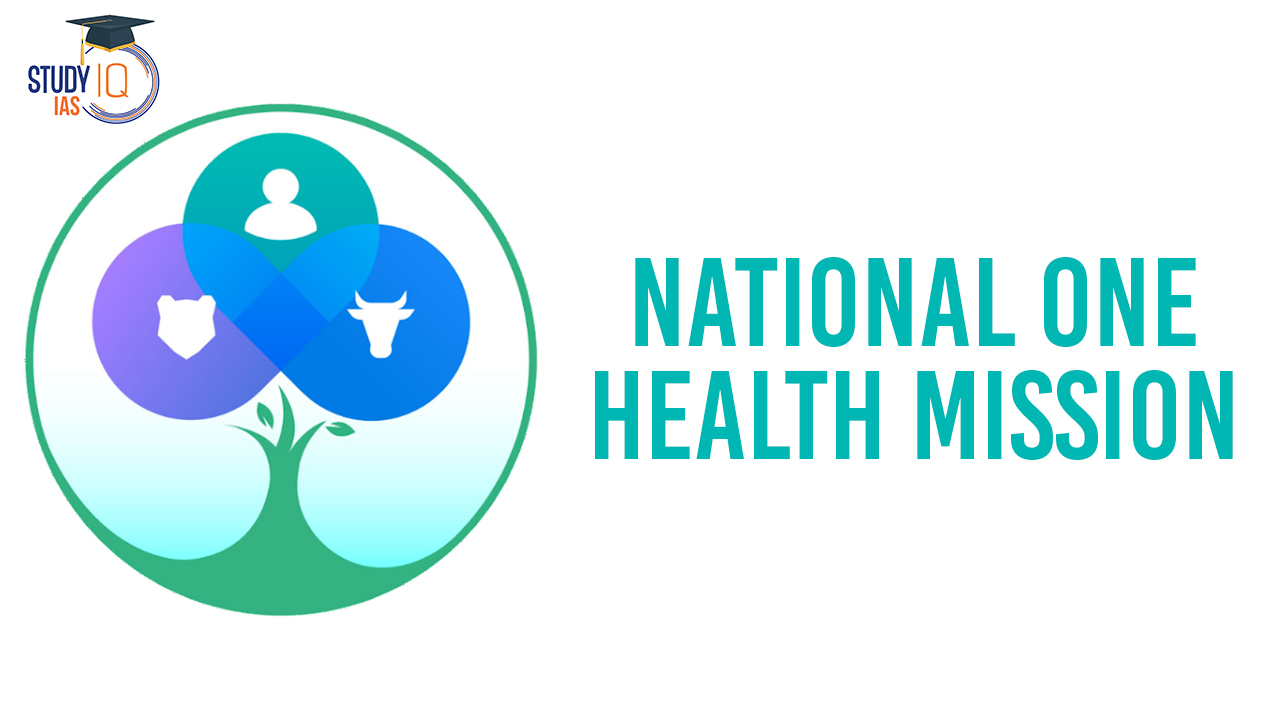Table of Contents
Context: Introduction to One Health Mission highlighted the interconnectedness of humans, animals, and the environment in the context of pandemics, exemplified by COVID-19 in humans and lumpy skin disease in livestock.
National One Health Mission
- Launched by the Indian government in July 2022.
- Aims for integrated disease surveillance, joint outbreak response, coordinated R&D, and seamless information sharing.
- Involves 13 Ministries/Departments and science funding agencies (DST, DBT, CSIR, Do Pharma, AYUSH, Health Ministry, Animal Husbandry Ministry, Environment Ministry, Defence Ministry).
- The National Institute for One Health was established in Nagpur as the nodal agency for national and international collaboration.
Goals of the Mission
- Better control of routine and pandemic diseases affecting humans (e.g., COVID-19), animals (e.g., foot and mouth disease, lumpy skin disease, canine distemper), and wildlife (e.g., avian influenza, Nipah).
- Strengthened R&D for vaccines, therapeutics, and diagnostics by DBT, CSIR, ICMR, ICAR, Do Pharma.
- Close collaboration between Centre, States, academia, and private sector.
- Achieve ‘One Health’ for a healthier planet (‘One Earth, One Health’) and ensure ‘Health for All’.
Key Initiatives
- National network of high-risk pathogen laboratories (BSL 3 & BSL 4) for better disease outbreak response across sectors.
- Utilising AI, machine learning, and disease modelling for improved epidemiology and data analysis.
- Expanding genomic surveillance (e.g., wastewater) and sentinel programs (monitoring animal congregations) for broader disease detection.
Global Collaboration
- ‘One Health’ approach endorsed by G-20 members under India’s presidency.
- Focus on building better surveillance and analytic capacities, and establishing an international network of ‘One Health’ institutes.
Significance
- Addresses complex challenges: One Health tackles interconnected issues like zoonotic diseases (diseases jumping between animals and humans), antimicrobial resistance, food safety, and climate change.
- Improves efficiency: By encouraging collaboration across sectors (health, environment, agriculture), One Health minimises resource duplication and promotes knowledge sharing.
- Cost-effective: Economically, a One Health strategy is more cost-effective in pandemic management, estimated to require $10.3 to $11.5 billion annually, compared to $30 billion a year for non-One-Health approaches, according to World Bank assessments and the G20 Joint Finance and Health Taskforce.
| Quote |
| “Between animal and human medicines there are no dividing lines – nor should there be.”
– German physician and pathologist Rudolf Virchow |
Recent One Health Initiatives
- India’s Standing Committee on Zoonoses (2006): Provides guidance on zoonotic disease challenges.
- India’s First One Health Consortium (Oct 2021): Assesses the burden of animal and zoonotic diseases, fostering collaboration across sectors.
- One Health Pilot Project (June 2022): Strengthens collaboration in Karnataka and Uttarakhand to improve animal, human, wildlife, and environmental health.
How to Switch to a One Health Approach: A Four-Stage Process
- Stage 1: Communication (Building Awareness and Engagement)
- Establish communication channels between various government ministries and relevant sectors (health, environment, agriculture).
- Keep stakeholders informed and engaged throughout the One Health transition.
- Facilitate regular meetings and progress reviews.
- Example: India’s National Standing Committee on Zoonoses under the Ministry of Health and Family Welfare (MoHFW).
- Stage 2: Collaboration (Knowledge Sharing and Joint Action)
- Promote knowledge and expertise exchange between sectors to translate ideas into action.
- Clearly define roles and responsibilities for each sector in managing zoonotic diseases (e.g., disease risk assessment, surveillance, capacity building, research, public outreach).
- Example: The Department of Animal Husbandry and Dairying’s (DAHD) One Health pilot project in Karnataka and Uttarakhand, which strengthens collaboration between sectors.
- Stage 3: Coordination (Long-Term Action and Oversight)
- Implement routine and long-term One Health initiatives led by a national or subnational agency with dedicated authority and resources.
- This agency should ideally be established specifically for One Health.
- Examples:
- Routine environmental and disease surveillance
- Monitoring animal and animal product trade across borders
- Conducting regular public awareness campaigns
- Stage 4: Integration (Breaking Down Silos and Creating Synergies)
- Shift government sectors from vertical (independent program management) to horizontal (collaborative and integrated) structures.
- Develop a policy framework for efficient resource sharing and streamlining existing programs across sectors.


 Pariksha pe Charcha 2025, Overview, Even...
Pariksha pe Charcha 2025, Overview, Even...
 Eklavya Model Residential Schools (EMRS)
Eklavya Model Residential Schools (EMRS)
 National Policy on Framework on Agricult...
National Policy on Framework on Agricult...




















